From Hue to Hoi An: The Scenic Route and Best Ways to Travel
If this is your first time traveling to Vietnam and you’re curious about how to get from Hue to Hoi An, this guide is for you. We’ll walk you through the most scenic route connecting these two destinations and highlight what you can enjoy along the way. We’ll also cover the best transportation options to make your journey smooth and enjoyable. Don’t miss the FAQs section, where we answer common questions from first-time travelers!
Overview
Must-see sights
Travel options
FAQs

Overview of Hue and Hoi An
Hue and Hoi An are two cities located in central Vietnam, with Hue situated to the north of Hoi An, about 120 km away. Both are famous tourist destinations, each with its own unique charm. Hue, once the capital of the Nguyen Dynasty, is rich in history and cultural heritage, while Hoi An, a bustling trading port in the 17th and 18th centuries, is a well-preserved town that showcases a blend of Vietnamese, Chinese, and Japanese influences.
To help you get a clearer picture of these two destinations, we’ve put together a detailed comparison of Hue and Hoi An. You can check out the full article on Hue vs Hoi An to dive deeper into the unique charm and differences of each city.
The journey from Hue to Hoi An
The distance from Hue to Hoi An is about 120 km, and the journey takes you through some beautiful landscapes. As you leave Hue, you’ll pass through peaceful rural villages and vast rice fields before reaching the famous Hai Van Pass. From there, the road continues down to Hoi An, passing through Da Nang, one of the busiest and most vibrant cities in Central Vietnam. It’s a journey that offers a perfect mix of natural beauty and urban charm.
Must-see sights on the route from Hue to Hoi An
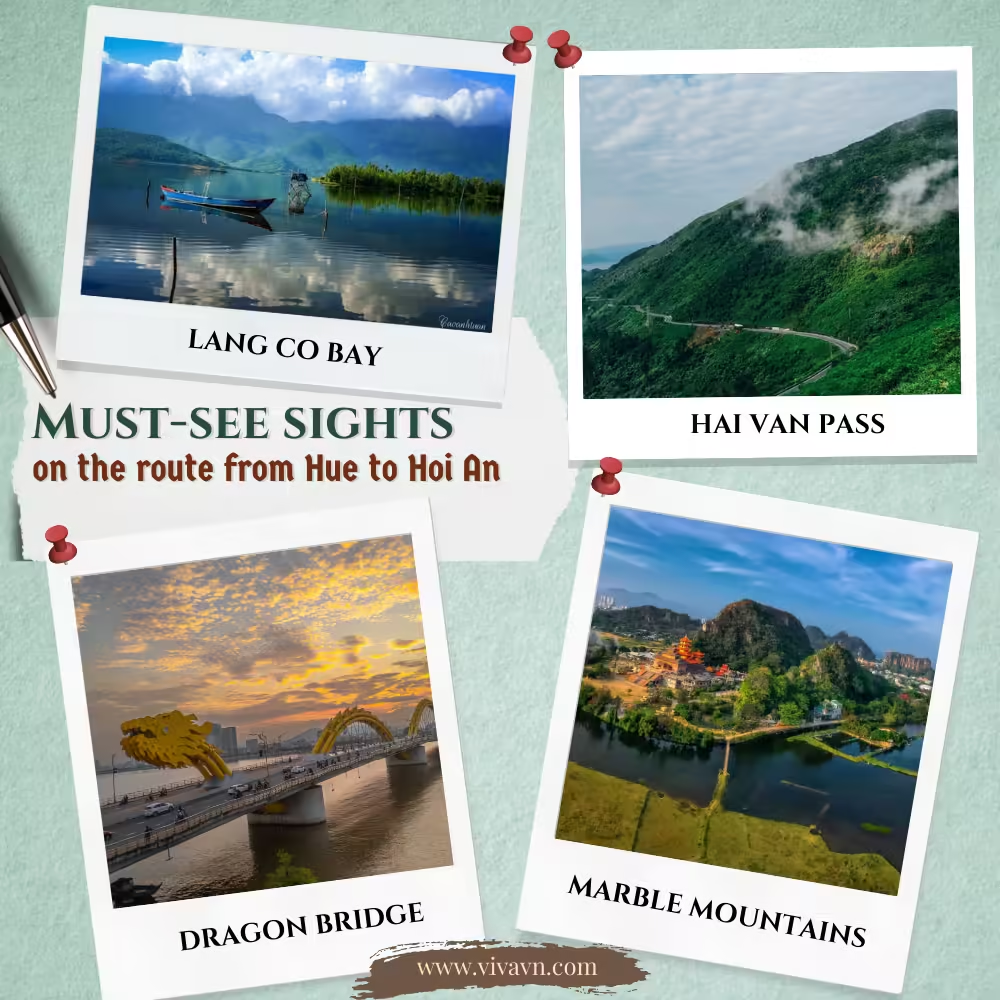
1. Lang Co Bay

Highlights:
Lang Co Bay, located at the base of the Hai Van Pass, is one of Vietnam’s most beautiful bays. It’s known for its pristine natural beauty and tranquil fishing villages.
Things to do:
Enjoy fresh, delicious seafood at seaside restaurants.
Take a peaceful walk around Lap An Lagoon or go for a swim in the bay’s clear waters.
2. Hai Van Pass

Highlights:
Stretching 20 kilometers (12 miles) and rising 500 meters (1,640 feet) above sea level, the Hai Van Pass offers lovely views. From its summit, you can take in panoramic sights of Lang Co Bay, Da Nang City, the East Sea, and majestic, rolling mountain ranges.
Things to do:
Explore Hai Van Gate, a historic landmark built in 1826.
Enjoy a cup of Vietnamese coffee at hillside cafes on Hai Van Pass while taking in stunning ocean views.
3. Dragon Bridge

Credit: Photo of Dragon Bridge by Huy Dope
Highlights:
The Dragon Bridge symbolizes Da Nang, spanning the Han River. This massive steel bridge, over 600 meters long, is designed in the shape of a dragon soaring toward the East Sea. Every weekend, visitors gather to watch fire and water shows as the dragon breathes flames and sprays water from its mouth.
Things to do:
Take photos with the bridge.
Enjoy the view of the Han River.
4. Marble Mountains

Credit: Photo of Marble Mountains by Huynh Van Truyen/ Kim Lien
Highlights:
The Marble Mountains consist of five separate limestone peaks, with the most notable being Thuy Son, which stands about 110 meters high. This mountain features mysterious caves and ancient temples at its summit.
Things to do:
Explore the unique caves on Thuy Son Mountain
Climb hundreds of stone steps to reach the ancient temples at the mountain’s summit
How to travel from Hue to Hoi An
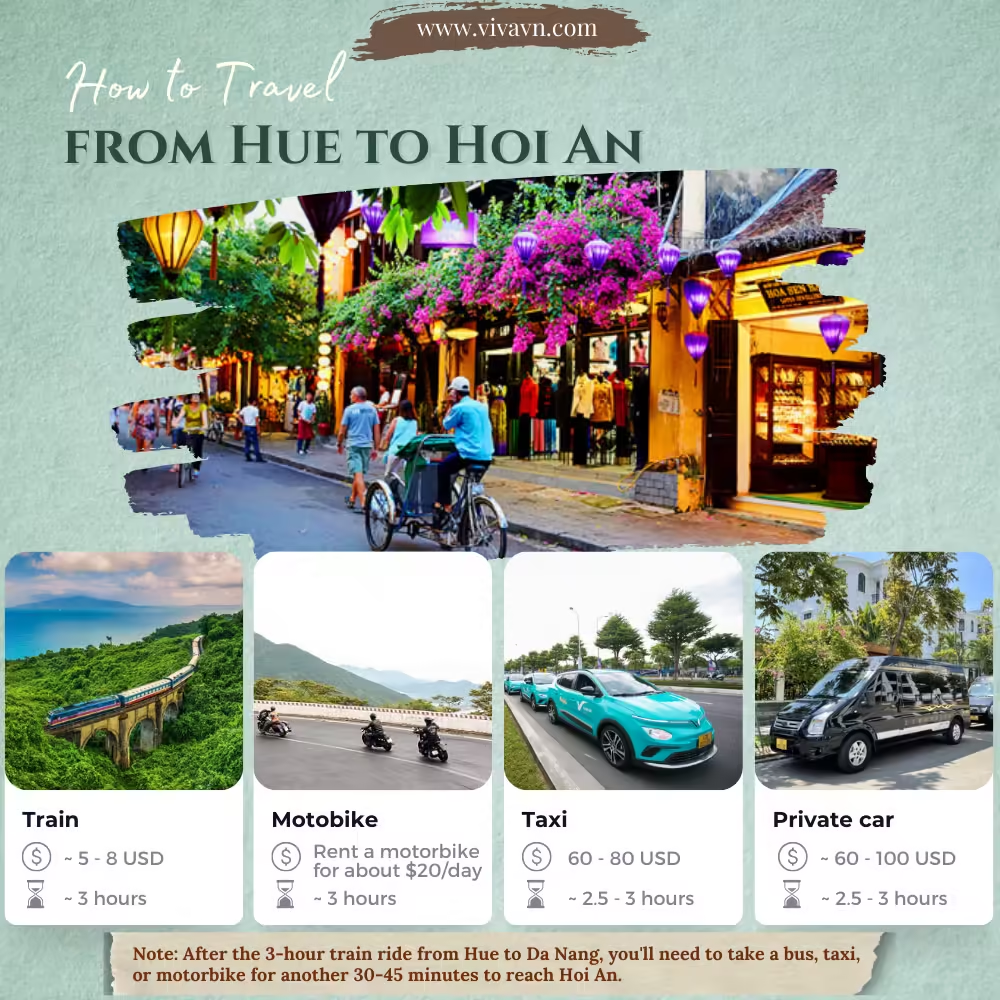
Train
Price: $5 – $8
Time: Approximately 3 hours by train, plus 30 minutes by bus or taxi.
We recommend taking the train from Hue to Da Nang. This journey offers some of the most stunning views in central Vietnam. You’ll pass through peaceful rice fields in Hue’s countryside, climb the scenic Hai Van Pass, and enjoy breathtaking views of Lang Co Bay from above. The lush greenery along the pass makes it a truly memorable experience.

Motorbike
Motorbike rental: around $20 per day
Time: About 3 hours.
Riding a motorbike from Hue to Hoi An gives you the freedom to stop and enjoy the views whenever you like. When you reach Hai Van Pass, you’ll have two options: take the Hai Van Tunnel or the scenic mountain route. We highly recommend the mountain pass for its stunning views.
Private Car
Price: About $60 – $100
Time: About 2.5 – 3 hours.
A private car from Hue to Hoi An offers flexibility and comfort, costing $60–$100 depending on seating capacity. The 2.5–3-hour trip includes stops like the Hai Van Pass.
Taxi
Price: About $60 – $80
Time: About 2.5 – 3 hours.
Taxis are convenient options with direct routes, but some companies allow scenic stops for an additional fee—be sure to confirm with the driver beforehand.
Shuttle bus
Price: About $10 – $20
Time: About 2.5 – 3 hours.
A shuttle bus is an affordable option for traveling from Hue to Hoi An, offering direct routes without stops for sightseeing along the way.
Common FAQs
Is the Hai Van Pass road safe for tourists traveling from Hue to Hoi An?
Yes, the Hai Van Pass is generally safe for tourists traveling from Hue to Hoi An. The road is well-maintained with stunning views, but it’s winding, so drive carefully, especially in fog, which is more common in the fall and winter, particularly between 5–6 AM and 4–6 PM. If you’re not comfortable driving, you can take a guided tour, taxi, or bus for a safer experience. Motorbikes are also popular but remember to wear a helmet and be cautious.
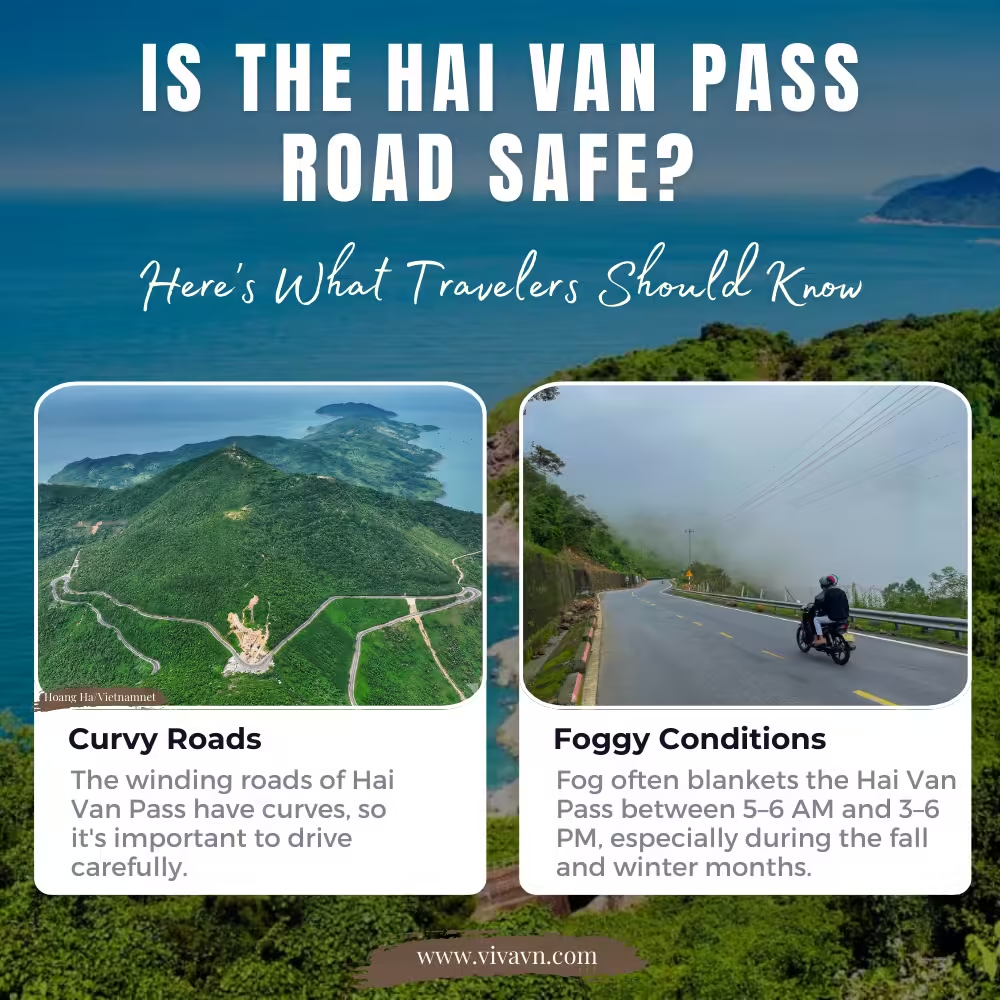
Is there a tunnel that avoids the Hai Van Pass?
Yes, there is a tunnel called the Hai Van Tunnel that allows you to avoid the Hai Van Pass. However, motorbikes are not allowed to go through the tunnel. Instead, you’ll be transferred by bus, and your motorbike will be transported as well. The fee for using the tunnel is around $2.

Is the Hai Van Tunnel faster than driving over Hai Van Pass?
Yes, the Hai Van Tunnel is faster than driving over the Hai Van Pass. The tunnel takes about 15 minutes, while the pass typically requires around 30 minutes of driving.
Can you do Hue as a day trip from Hoi An?
While it’s possible to visit Hue from Hoi An in one day, it might not give you enough time to fully experience the city’s rich history and culture. With a 2-3 hour drive each way, you’ll likely spend a lot of time on the road. If you prefer a more relaxed pace, it’s better to plan for at least an overnight stay in Hue to truly enjoy the main sights without feeling rushed. Check out our article comparing Hue and Hoi An for more details.
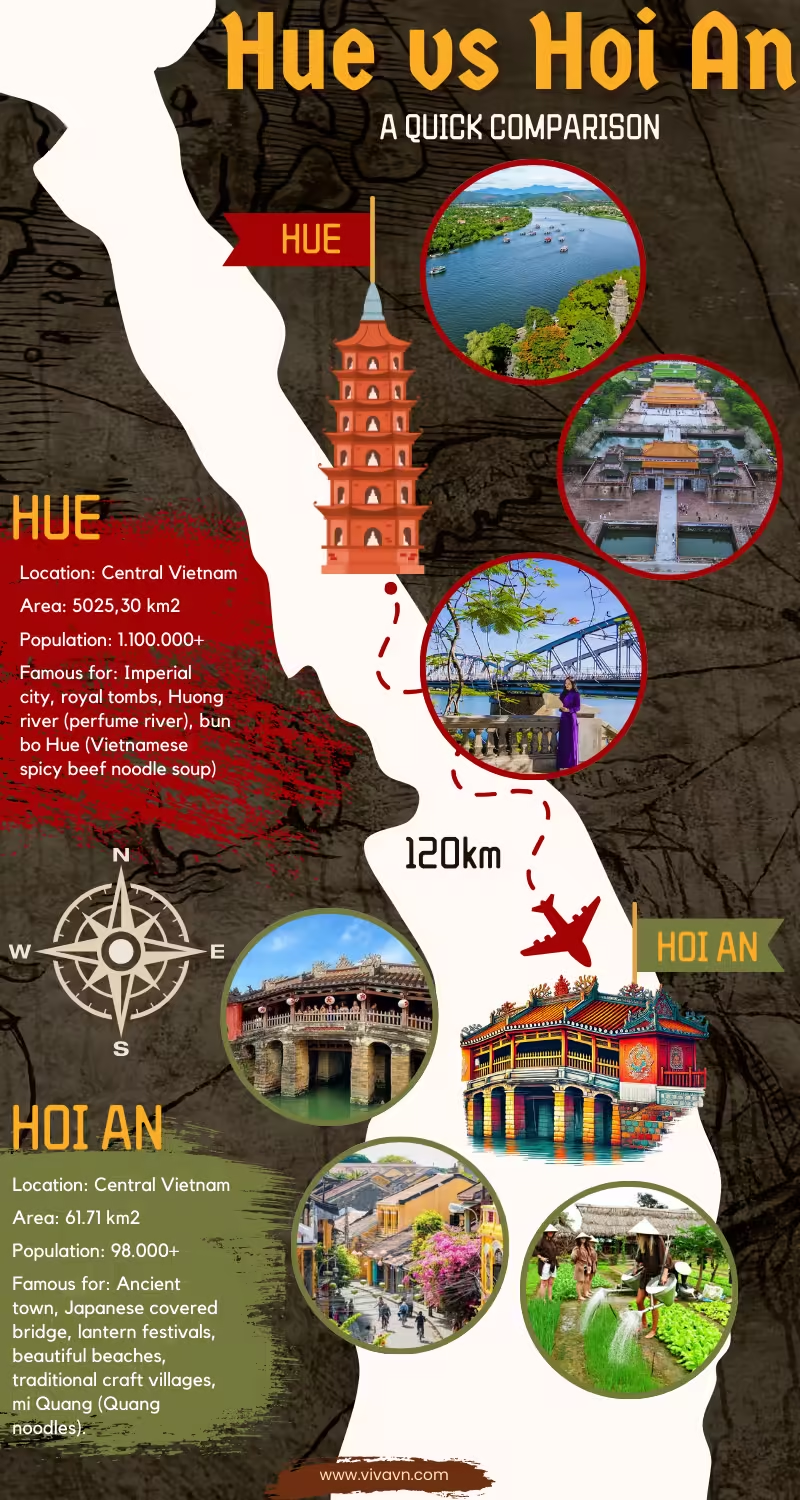
How long does it take to drive from Hue to Hoi An?
Driving from Hue to Hoi An typically takes around 2.5 – 3 hours, depending on traffic and weather conditions. Along the way, you can stop at stunning spots like Hai Van Pass or Lang Co Bay, which might add some extra time
How much does a taxi from Hue to Hoi An cost, and how long does it take?
The cost of a taxi from Hue to Hoi An typically ranges around $60 – $80, depending on the taxi company. Some companies may also charge extra fees if you plan to make stops at tourist attractions along the way, so it’s a good idea to ask the driver about that in advance. The journey usually takes around 2.5 to 3 hours, depending on traffic. Popular taxi services such as Xanh SM offer eco-friendly electric vehicles.
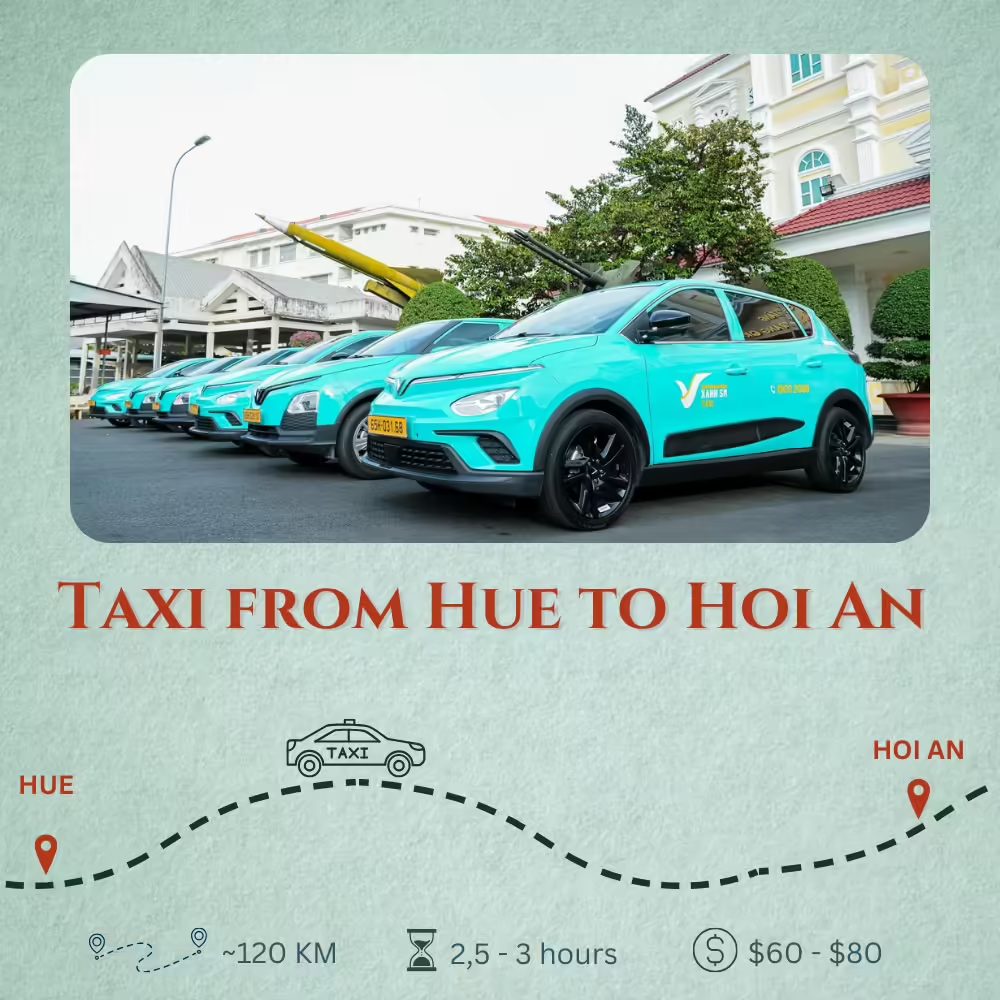
Share on FacebookShare on X (Twitter)Share on PinterestShare on WhatsappShare on LinkedinShare on TelegramShare on Email
- https://www.youtube.com/@VivaVNOfficial
- https://www.facebook.com/vivavnofficial2024
- https://www.pinterest.com/vivavnofficial/
© 2025 VivaVN. All rights reserved.


Leave a Reply